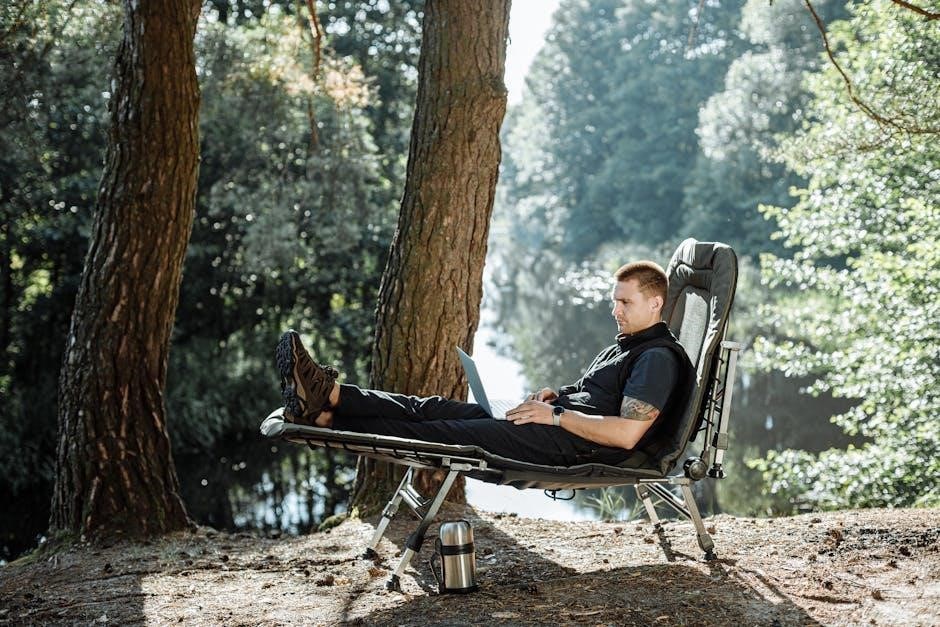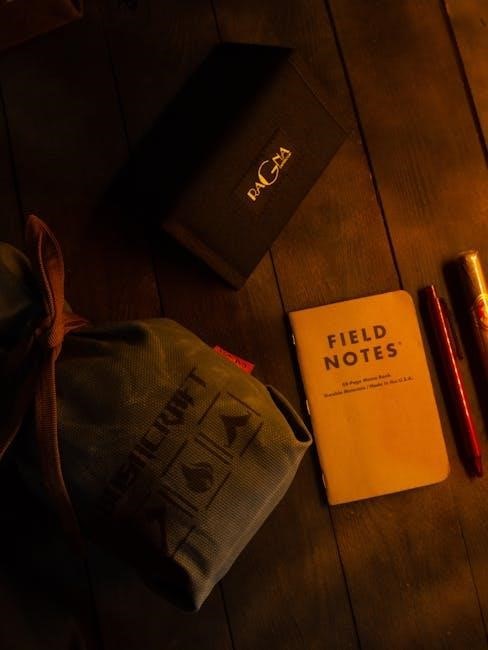Susan Sontag’s Notes on Camp is a seminal essay exploring the camp aesthetic, defining it as a sensibility that celebrates artifice, extravagance, and playful irony, shaping cultural discourse.
1.1 Definition and Overview of Camp Aesthetic
Camp aesthetic, as explored in Susan Sontag’s Notes on Camp, refers to a sensibility that celebrates artifice, extravagance, and playful irony. It is a way of engaging with the world that prioritizes style and surface over depth or sincerity. Camp often involves a deliberate theatricality, embracing the absurd and the exaggerated. It sees life as a performance, where identity and reality are fluid and subject to reinterpretation. This aesthetic thrives on contradiction, blending high and low culture, and often challenges traditional notions of beauty and taste. Camp’s essence lies in its ability to transform the mundane into the extraordinary, creating a unique visual and emotional language that resonates deeply with marginalized communities, particularly in queer culture.

1.2 Historical Context of Susan Sontag’s Essay
Susan Sontag’s essay Notes on Camp was first published in 1964, a time of cultural and social transformation in the United States and Europe. The essay emerged amidst a growing interest in pop culture, avant-garde art, and the questioning of traditional aesthetic norms. Sontag’s work was groundbreaking, as it brought the concept of camp into academic and mainstream discourse, exploring its roots in queer subcultures and its broader cultural significance. The essay’s historical context is marked by the Civil Rights Movement, the rise of counterculture movements, and the expanding visibility of LGBTQ+ identities, all of which influenced Sontag’s analysis of camp as a subversive and liberating sensibility. Her work remains a cornerstone in understanding camp’s cultural and political implications.

Key Elements of Camp Sensibility
Camp sensibility thrives on artificiality, extravagance, and irony, embracing the theatrical and the absurd while celebrating playful subversion of norms through exaggerated expression and deliberate flamboyance.

2.1 Artificiality and Extravagance in Camp Culture

Camp culture thrives on artificiality and extravagance, rejecting naturalness in favor of exaggerated, theatrical expressions. It celebrates the “quotational” nature of life, where objects and people are seen as performances rather than authentic entities. Camp delightedly embraces the absurd, the excessive, and the stylized, often subverting traditional notions of beauty and taste. This sensibility is deeply rooted in a love for artifice, where the surface matters more than depth. By glorifying the theatrical and the hyperbolic, camp challenges the seriousness of mainstream culture, creating a space for playful rebellion and self-expression. Its emphasis on extravagance allows camp to transcend mundane reality, fostering a world of deliberate excess and androgynous flair.
2.2 The Role of Irony and Playfulness
Camp sensibility is deeply intertwined with irony and playfulness, which serve as tools to subvert seriousness and challenge norms. Irony in camp is not merely about humor but about recontextualizing objects and ideas, often to expose their underlying absurdity or pretense. Playfulness allows camp to flirt with the boundaries of taste, creating a space where the ridiculous and the sublime coexist. This approach fosters a sense of detachment and amusement, enabling camp to critique cultural norms without taking them too seriously. Through irony and play, camp transforms the mundane into the extraordinary, offering a unique lens through which to view and interpret the world.

Camp and Identity
Camp serves as a creative outlet for self-expression, particularly for marginalized communities, challenging traditional norms and fostering identity through its embrace of artifice and theatricality.
3.1 Camp as a Queer Aesthetic
Camp has long been intertwined with queer identity, serving as a vibrant expression of nonconformity and self-empowerment. It celebrates exaggerated aesthetics and challenges normative gender roles, providing a space for marginalized voices to thrive. By embracing artifice and theatricality, camp becomes a political tool, subverting societal expectations and reclaiming power through humor and irony. It has been a cornerstone of LGBTQ+ culture, influencing drag performances, fashion, and media. Camp’s queer sensibility is not just about style but about resilience, fostering a community that rejects conformity and celebrates difference. Its enduring relevance lies in its ability to evolve, remaining a powerful symbol of queer resistance and creativity.
3.2 The Intersection of Camp and Sexuality
Camp’s relationship with sexuality is profound, often expressing non-normative desires and challenging traditional norms. It thrives on playful ambiguity, allowing exploration of fluid identities and subverting rigid binaries. Camp aesthetics, particularly in drag and queer performance, celebrate exaggerated sexual expression, blending humor and provocation. This sensibility provides a space for marginalized voices to reclaim and redefine sexuality, emphasizing theatricality over conventional norms. By embracing artifice, camp liberates sexuality from societal constraints, fostering a culture of self-expression and resistance. Its influence is evident in contemporary queer culture, where camp continues to inspire new ways of navigating and celebrating sexual identity, making it a powerful tool for liberation and empowerment.

Camp in Contemporary Culture
Camp’s influence is evident in modern fashion, art, and media, where its exaggerated style and irony continue to inspire creativity and challenge norms, ensuring its enduring relevance today.
4.1 Camp’s Influence on Fashion and Art
Camp’s influence on fashion and art is profound, embracing artifice and extravagance. Designers like Versace and Mugler have leveraged camp’s dramatic flair, creating bold, theatrical collections. The 2019 Met Gala, themed around camp, showcased its cultural impact, celebrating exaggerated styles and playful irony. In art, camp inspires works that blend humor with subversion, challenging traditional notions of beauty and taste. By prioritizing surface over depth, camp encourages experimentation, fostering a space where fashion and art collide to create visually striking, thought-provoking statements. This aesthetic continues to inspire creators, proving camp’s enduring relevance in contemporary culture.
4.2 Camp in Film, Television, and Media
Camp has flourished in film, television, and media, blending irony, melodrama, and exaggerated aesthetics. Classic films like The Rocky Horror Picture Show and Moulin Rouge! embody camp’s playful sensibility, while TV shows such as RuPaul’s Drag Race celebrate camp’s theatricality and self-aware humor. Modern media continues to embrace camp, with streaming platforms showcasing camp-influenced series and movies. This aesthetic challenges traditional norms, offering audiences a space for escapism and subversive commentary. By amplifying drama and artifice, camp in media remains a powerful tool for storytelling and cultural critique, ensuring its enduring relevance in contemporary entertainment.

Practical Applications of Camp
Camp’s practical applications include fostering self-expression and challenging norms through exaggerated styles and humor, allowing individuals and communities to embrace identity and creativity while addressing social issues.
5.1 Camp in Everyday Life and Self-Expression
Camp aesthetic influences daily life through bold fashion choices, exaggerated humor, and a playful approach to identity. It encourages individuals to embrace artifice and irony, transforming mundane routines into performances. By celebrating the artificial, camp empowers self-expression, allowing people to craft personas that defy conventional norms. This sensibility flourishes in queer culture, where it becomes a tool for reclaiming and redefining identity. In everyday life, camp inspires creativity, whether through vibrant outfits or witty banter, fostering a sense of community among those who share its values. Ultimately, camp in self-expression is about asserting individuality and challenging societal expectations through a lens of theatricality and fun.

5.2 Camp as a Tool for Social Commentary
Camp serves as a powerful vehicle for social critique, using humor, irony, and exaggeration to highlight societal norms and challenge them. By amplifying the artificial and absurd, camp exposes underlying hypocrisies in culture, politics, and identity. It subverts serious discourse, offering a unique lens to address issues like gender roles, sexuality, and class. Through camp, marginalized voices can critique power structures playfully yet effectively, making complex ideas more accessible. This approach not only entertains but also provokes reflection, fostering a dialogue that encourages change. Camp’s ability to blend wit with insight makes it a compelling tool for social commentary in both art and everyday life.
Susan Sontag’s Notes on Camp remains a pivotal exploration of camp’s enduring relevance, emphasizing its subversive power to challenge norms and celebrate the artifice of life and culture.
6.1 The Timeless Relevance of Camp
Camp’s enduring relevance lies in its ability to challenge norms and embrace artifice, offering a unique lens to view culture. Its blend of irony, extravagance, and playfulness continues to inspire, evolving with societal changes. Camp transcends time, adapting to new forms of expression while maintaining its core essence of celebrating the artificial and the dramatic. It remains a powerful tool for self-expression and identity, particularly within queer communities, where it has historically provided a voice and a platform for marginalized groups. Today, camp’s influence is evident in fashion, film, and media, proving its timeless appeal as a sensibility that thrives on creativity and subversion.
6.2 Future of Camp Aesthetic in Modern Society
Camp’s future in modern society is promising, as its themes of artifice and irony resonate deeply in today’s hyper-visual, social media-driven world. The aesthetic continues to evolve, blending with contemporary trends in fashion, art, and entertainment. Camp’s ability to subvert norms and challenge traditional values ensures its relevance, particularly in advocating for inclusivity and self-expression. As digital platforms amplify camp’s visibility, it will likely inspire new forms of creative resistance and cultural critique. By embracing excess and playfulness, camp remains a vibrant force, shaping identities and fostering innovation in an ever-changing world.
